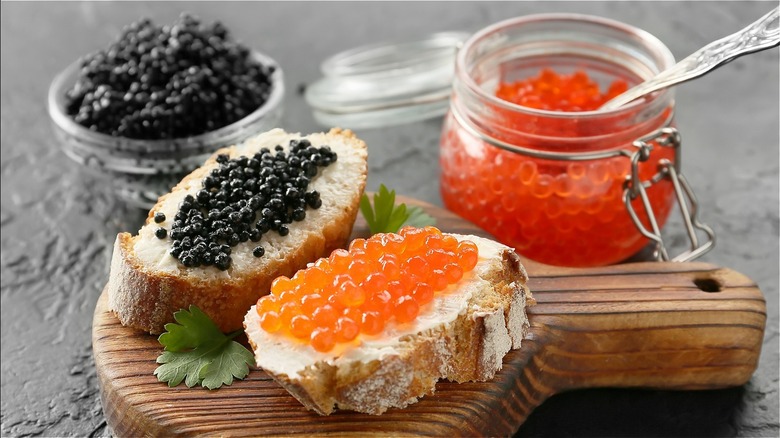Should Caviar Always Be Eaten With A Silver Spoon?
We may receive a commission on purchases made from links.
If you're planning to consume some caviar, perhaps a silver spoon is already dangling from your mouth. Said spoon can also typically be found cradling the little beads of lovely, fishy roe that are sitting in a dish and waiting to be slathered on blini, topped with crème fraîche, and popped into your mouth. But it looks like you may have been misinformed about the perfect way to serve caviar, AKA the roe or eggs of a sturgeon. It turns out that the type of spoon you choose is an important consideration. And silver, while an elegant form of tableware, is not the best choice.
Traditionally, caviar spoons were made from materials other than metal, including the tusk, shell, bone, or horn of an animal — before the methods of acquiring those resources were deemed unacceptable and illegal. Nowadays, with caviar being more accessible and affordable from places like Costco, Whole Foods, Amazon, and Caviar Lover, you're more likely to enjoy this delicacy with a spoon made of plastic or disposable wood. Though these might not seem as fancy as silver, they'll make your caviar taste better.
Christopher Klapp of Petrossian — a family that has been in the caviar business for nearly a century — told Food & Wine that metal actually interferes with caviar's delicate flavor because the roe takes on the taste of the spoon. Instead, there's another material he recommends for both its elegance and origin.
Serve caviar with a spoon made from mother of pearl
Given that caviar comes from the sea, Klapp cleverly suggests using a spoon made of materials from the same source, such as mother of pearl or mollusk shell.
The information listed on Whole Foods' "Unpretentious Guide to Caviar" confirms that dainty mother-of-pearl spoons are a great choice for serving caviar, although "you might not have one of those lying around." Remedy that void by ordering a single mother of pearl spoon for $10 or a set of five for $20 (from gourmet food purveyor Kolikof). Otherwise, just use your hand; caviar "bumping" goes back to a tradition among chefs of tasting a tiny sampling of caviar from the space between the thumb and index finger.
Whatever you use to spoon caviar onto your potato chips, you should first know that caviar and roe are not interchangeable terms. The difference is that roe describes all fish eggs, while caviar only comes from sturgeon. In fact, caviar was enjoyed as early as the fourth century B.C., when Aristotle would break from Greek philosophizing to treat himself to ancient fish eggs. However, it was Russia and the tsars "that catapulted caviar into the world of utter luxury," says Gourmet Food Store. Gradually, the wild sturgeon population decreased, followed by a ban on production in Russia and Iran in the early 2000s. Popular sources for caviar today are sturgeon farms in Romania, Italy, and China.

